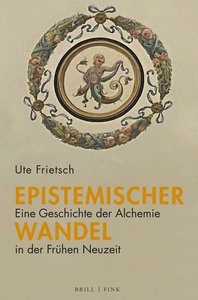Aktuelles
Neuerscheinungen
Ute Frietsch: Epistemischer Wande. Eine Geschichte der Alchemie in der Frühen Neuzeit. München: Brill 2024. XI, 620 S. ISBN 978-3-7705-6783-6
Zur Verlagshomepage

In der Alchemie der Frühen Neuzeit wurde argumentiert und wissenschaftlich geforscht. Die Monographie untersucht Entwicklungsdynamiken der Alchemie und erzählt deren Geschichte für die Zeit von ca. 1500 bis ca. 1830. Sie zeigt sowohl deren Eigenheiten wie deren Nähe zur modernen Chemie auf. Alchemiker grenzten sich zwar von dem universitären Wissen ihrer Zeit ab. Zugleich strebten sie jedoch nach einer Aufnahme ihrer Theorien und Praktiken an den Universitäten. Die Prozesse der Abgrenzung und der Anpassung initiierten einen Wandel der Wissensstruktur der Alchemie, der ihre Konzepte, Methoden, Gegenstände, Theorien, Praktiken und sprachlichen Darstellungsformen betraf. Ihren Ambitionen entsprechend waren Alchemiker nicht allein an Höfen, sondern auch an den medizinischen Lehrstühlen erfolgreich. Alchemikerinnen und Alchemiker trugen zum materiellen Wohlstand bei. Ihre Theorien und Praktiken veränderten die Universitäten sowie den Alltag der Menschen.
Ute Frietsch (Hg.): Alchemy and the Early Modern University. Ambix. The Journal of the Society for the History of Alchemy and Chemistry 68 (2021), Issue 2–3.
Open Access: https://www.tandfonline.com/toc/yamb20/68/2-3
“The question of institutional association is crucial for the historical assessment of alchemy and for the determination of its intellectual place in early modern Europe. In that regard, an assumed disconnect between alchemy and the university has played a decisive role in its historical appraisal. Perceived as an occult practice, historical alchemy has long been treated outside the precincts of European academic learning. Recent decades, however, have witnessed a change in this traditional picture with ground-breaking and detailed research brought to bear upon uncovering alchemy’s knowledge networks, terminology, methods, and technical procedures. Re-examining the question of alchemy’s standing at early modern European universities was the intention of an International Conference, ‘Alchemy and University,’ which took place at the Herzog August Bibliothek Wolfenbüttel in November 2019. The papers included in this special issue of Ambix derive from that conference.” (Ute Frietsch: Alchemy and the Early Modern University: An Introduction, Open Access: https://doi.org/10.1080/00026980.2021.1936800)
Zu der Tagung "Alchemy and University – Alchemie und Universität" (Herzog August Bibliothek Wolfenbüttel, 20. bis 22. November 2019) liegt folgender Tagungsbericht vor:
Projekte
In der Herzog August Bibliothek wird derzeit ein DFG-Projekt im Programm „Eigene Stelle” zum Thema Alchemie durchgeführt:
„Die Materialisierung von Robert Fludds alchemischen und theosophischen Konzepten: Eine wissenschaftsgeschichtliche Fallstudie zum Zusammenwirken von Autor, Handwerkern, Künstlern und Verlegern/The Materialisation of Robert Fludd's Alchemical and Theosophical Concepts: A Case Study in the History of Science on the Interaction between Author, Artisans, Artists, and Publishers”. Durchgeführt von PD Dr. Ute Frietsch.
Abstract: Fludd's books are distinguished by their spectacular images and luxurious size, which were produced by Matthäus Merian the Elder and Johann Theodor de Bry on his behalf. The relevance of images and artefacts – e.g. alchemical instruments, automates, and books – for Fludd's natural history and natural philosophy can be explained against the backdrop of “artisanal epistemology” (Pamela Smith), that is, the special relevance of crafts for alchemical scholarship around 1600. The analysis of the practical materialisation of Fludd's visual ideas and artefacts is a desideratum, since researchers – with the exception of Frances Yates and Robert Westman – have focused primarily on their philosophical relevance and little on the process of their production. This project will focus on the production of images and artefacts, which was concomitant with Fludd's main work “Utriusque cosmi historia.” To this end, the project will analyse Fludd's communication with his artists and artisans – i.e. his etchers and copperplate engravers, his writing assistants, laboratory helpers, drawing assistants (amanuenses), and publishers. The project's questions will be developed through the autoptical research of Ms. lat. qu. 15, “De technica microcosmi historia” at Frankfurter Stadt- und Universitätsbibliothek which demonstrates concrete processes of negotiation between author and publisher and has been almost entirely overlooked by prior research, and better-known manuscripts at Bodleian Library (Oxford), British Library (London), Trinity College (Cambridge), and Uppsala University. The close interlinking of text and image and the process of terminologically lettering images demonstrate that Fludd was not only vividly expressing his visual ideas in texts, but was also actively participating in materialising them, for example through pen drawings, which were used by Merian as models for his etchings and copperplate engravings. Fludd's adversaries, such as Kepler, treated these images as scholarly assertions, which Fludd was obliged to explain and defend in ensuing controversies. The project also intends to reconstruct the relationship between Fludd's images and his instruments, such as his automates, by their concrete as well as epistemic dimensions of production.





